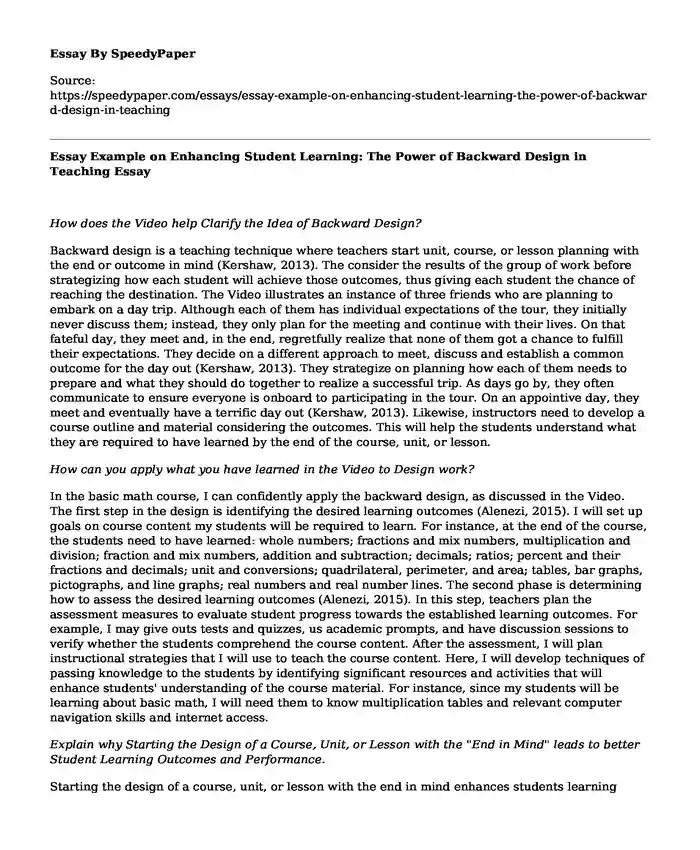How does the Video help Clarify the Idea of Backward Design?
Backward design is a teaching technique where teachers start unit, course, or lesson planning with the end or outcome in mind (Kershaw, 2013). The consider the results of the group of work before strategizing how each student will achieve those outcomes, thus giving each student the chance of reaching the destination. The Video illustrates an instance of three friends who are planning to embark on a day trip. Although each of them has individual expectations of the tour, they initially never discuss them; instead, they only plan for the meeting and continue with their lives. On that fateful day, they meet and, in the end, regretfully realize that none of them got a chance to fulfill their expectations. They decide on a different approach to meet, discuss and establish a common outcome for the day out (Kershaw, 2013). They strategize on planning how each of them needs to prepare and what they should do together to realize a successful trip. As days go by, they often communicate to ensure everyone is onboard to participating in the tour. On an appointive day, they meet and eventually have a terrific day out (Kershaw, 2013). Likewise, instructors need to develop a course outline and material considering the outcomes. This will help the students understand what they are required to have learned by the end of the course, unit, or lesson.
How can you apply what you have learned in the Video to Design work?
In the basic math course, I can confidently apply the backward design, as discussed in the Video. The first step in the design is identifying the desired learning outcomes (Alenezi, 2015). I will set up goals on course content my students will be required to learn. For instance, at the end of the course, the students need to have learned: whole numbers; fractions and mix numbers, multiplication and division; fraction and mix numbers, addition and subtraction; decimals; ratios; percent and their fractions and decimals; unit and conversions; quadrilateral, perimeter, and area; tables, bar graphs, pictographs, and line graphs; real numbers and real number lines. The second phase is determining how to assess the desired learning outcomes (Alenezi, 2015). In this step, teachers plan the assessment measures to evaluate student progress towards the established learning outcomes. For example, I may give outs tests and quizzes, us academic prompts, and have discussion sessions to verify whether the students comprehend the course content. After the assessment, I will plan instructional strategies that I will use to teach the course content. Here, I will develop techniques of passing knowledge to the students by identifying significant resources and activities that will enhance students' understanding of the course material. For instance, since my students will be learning about basic math, I will need them to know multiplication tables and relevant computer navigation skills and internet access.
Explain why Starting the Design of a Course, Unit, or Lesson with the "End in Mind" leads to better Student Learning Outcomes and Performance.
Starting the design of a course, unit, or lesson with the end in mind enhances students learning outcomes and performance. The methodology of backward design helps teachers organize results, assessments, and materials that fulfill the requirements of diverse students and help them learn (Alenezi, 2015). The step of identifying outcomes is directly connected to the motivation of students. The course content is considered more crucial than techniques of motivating students to learn; thus, teachers have to consider the content to input in the curriculum and how to use materials in teaching. This design ensures teachers offer students relevant knowledge, consequently allowing them to appreciate the course content and enhance their learning behavior, such as being more attentive in class. Determining appropriate assessment measures for the learning outcomes boosts the students' ability to understand, explain, interpret, and gain self-knowledge. This allows students to realize their achievements and success, therefore, fueling their self-confidence (Alenezi, 2015). Generally, this design inspires students to learn by motivating teachers to strategize essential learning methods, and experiences that enable students to comprehend course concepts and actively engage in learning.
References
Alenezi, H. (2015). Learning as the Prize: Enhancing Students' Intrinsic Motivation through Backward Design. International Journal of Pedagogy and Curriculum, 23(1), 2.
Kristine Kershaw. (2013, August 25). What is Backward Design? [Video]. Youtube. https://www.youtube.com/watch?v=3Xzi2cm9WTg&feature=youtu.be
Cite this page
Essay Example on Enhancing Student Learning: The Power of Backward Design in Teaching. (2023, Oct 16). Retrieved from https://speedypaper.com/essays/essay-example-on-enhancing-student-learning-the-power-of-backward-design-in-teaching
Request Removal
If you are the original author of this essay and no longer wish to have it published on the SpeedyPaper website, please click below to request its removal:
- Paraphrasing Essay Sample
- Education Essay Sample for You: Global Challenges in Higher Education
- Essay Example: Professional Interview with a Teacher
- Essay Sample: English Literature Lesson
- Paper Example: Impact Of Education On Nursing And Its Future
- Understanding IEP: An Essay Sample on Individualized Education Programs for Children with Disabilities
- Free Essay Example - Self-Management and Information on Diabetes
Popular categories





